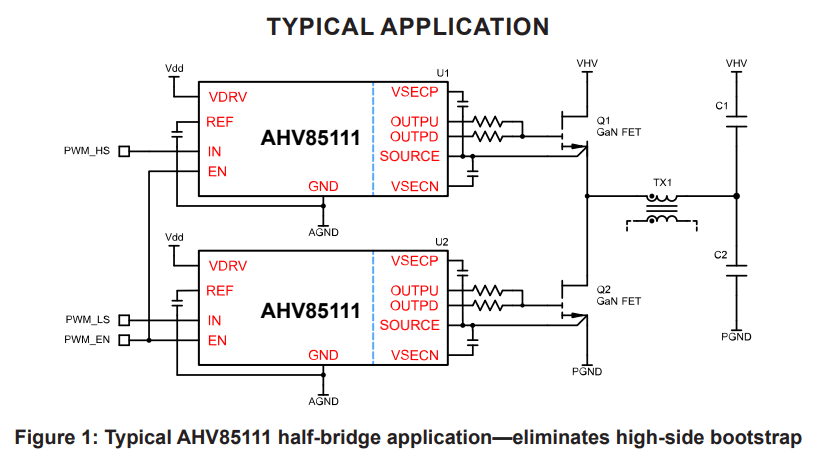The AHV85111 offers precise and flexible gate drive for GaN FETs, with a regulated bipolar output, adjustable positive rail, and integrated bias supply for simplified design and improved dv/dt immunity.
Product Details
Product Details
Top Features
- Transformer isolation barrier
- Power-Thru integrated isolated bias
- No need for high-side bootstrap
- No need for external secondary-side bias
- AEC-Q100 Grade 2 qualification
- Bipolar drive output with adjustable regulated positive rail
- Built-in primary-side 3.3V REF bias output
- 50ns propagation delay
- Separate drive output pins: pull-up (2.8 Ω) and pull-down (1.0 Ω)
- Supply voltage 10.8 V < VDRV < 13.2 V
- Undervoltage lockout on primary VDRV and secondary VSEC
- Enable pin with fast response
- Continuous ON capability—no need to recycle IN or recharge bootstrap capacitor
- CMTI > 100 V/ns dv/dt immunity
- Creepage distance 8.4 mm
- Safety Regulatory Approvals
- 5 kV RMS VISO per UL 1577
- 8 kV pk VIOTM maximum transient isolation voltage
- 1 kV pk maximum working isolation voltage
Target Application
- DC-DC Converter
- Auxilary Inverter
- On-board Charger
- Server Power
- C&I Solar String Inverters
Part Number Specifications and Availability
AHV85111 Product Overview
The AHV85111 isolated gate driver is optimized for driving GaN FETs in multiple applications. An isolated dual positive/negative output bias supply is integrated into the driver device, eliminating external gate drive auxiliary bias supply or high-side bootstrap.
0:00
Technical Documentation

Application Note
Minimizing PCB Parasitic Effects with Optimum Layout of the Gate Driver Loop Applicable to AHV85110 AND AHV85111 Gate Drivers

Application Note
AHV85111 Design and Application Guide

Brochure
Robust and Efficient Power Supply Units (PSUs) for Cloud Infrastructure New

Brochure
Robust and Efficient UPS Solutions Powered by Allegro New

Brochure
Precision in Motion: Powering the Future of Collaborative Robotics

Brochure
通过可持续性实现舒适性

Brochure
DC 快速充电:速度更快、行程更远

Brochure
太阳能收集

Guide
APEK85111KNH-02-T-MH- Evaluation Board User Guide

Guide
APEK85111KNH-01-T-MH Evaluation Board User Guide

Infographic
Power-Thru-Technology Infographic

Technical Article
Simplify Designs and Reduce Overall Systems Cost by Eliminating External Power Supplies

Technical Article
Solving the Challenges of Increasing Power Density by Reducing Number of Power Rails

Technical Article


